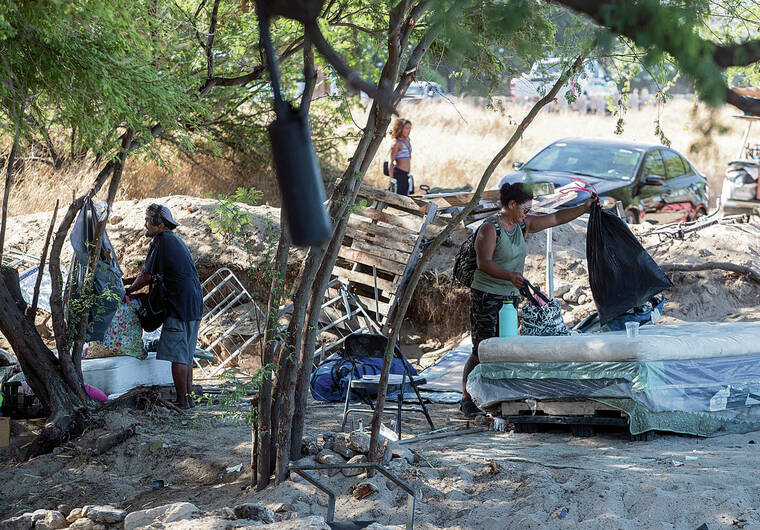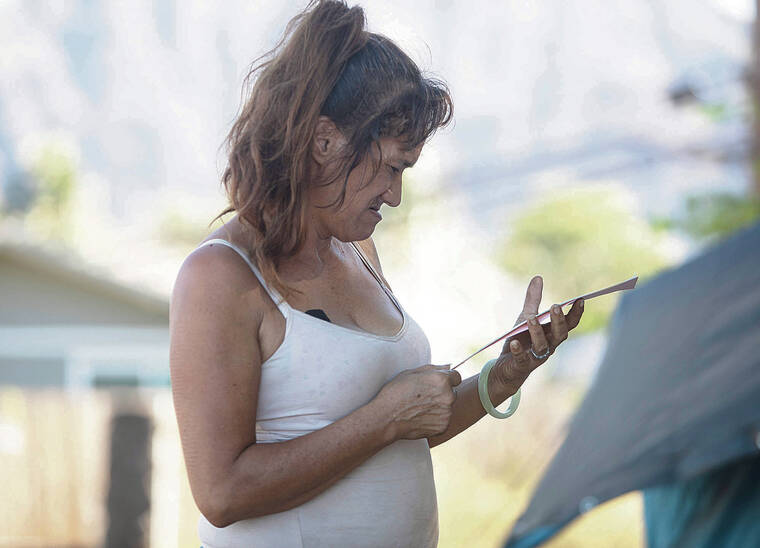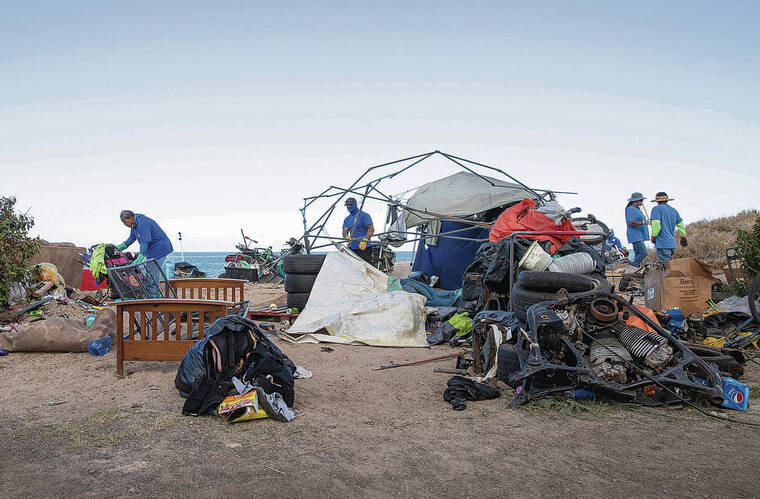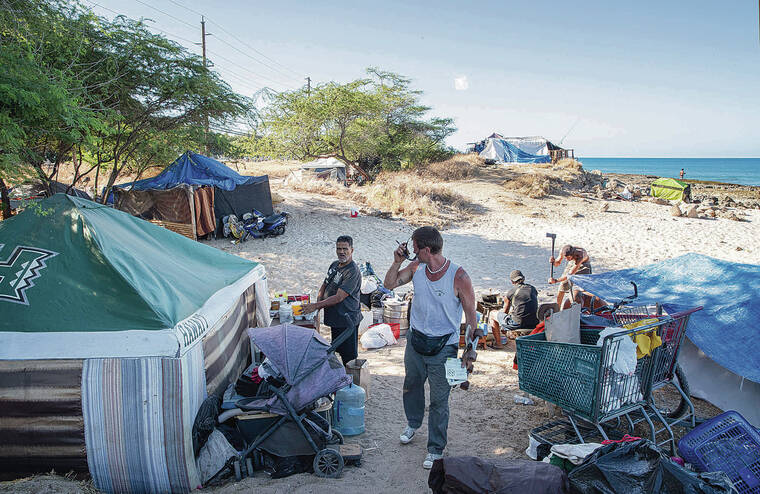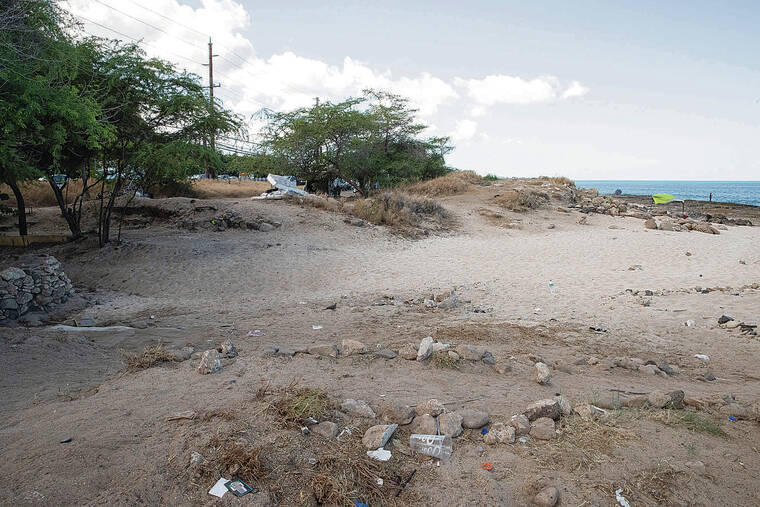Honolulu Department of Parks and Recreation workers hauled heaps of trash, mattresses and furniture into trucks, clearing what was a chronic homeless encampment on Lualualei Beach Park along the Waianae Coast — but Mayor Rick Blangiardi insisted it was not a homeless “sweep.”
Blangiardi called Thursday’s cleanup a “sanitation” action and not a continuation of former Mayor Kirk Caldwell’s “compassionate disruption” approach to reducing homelessness, which offered social service help combined with cleanups and the threat of law enforcement action.
When he campaigned for mayor, Blangiardi blasted “compassionate disruption” as ineffective.
Now Blangiardi is searching for the third person to take over the city’s homeless efforts in less than two years.
Thursday’s clearing of Lualualei Beach Park came just a day before Trish La Chica, executive director of the city’s office of Housing and Homelessness — left the city Friday after about six months.
Her predecessor, Anton Krucky, was promoted in October to take over the Department of Community Services, which oversees the office of Housing and Homelessness.
La Chica’s replacement will take over responsibility for a homeless problem that 66% of Oahu residents say has gotten worse over the past 12 months, according to the results of this month’s Honolulu Star-Advertiser Hawaii Poll.
Regardless of what they’re called, out on the street the city’s “sanitation” actions have grown increasingly aggressive, said Kapiolani “Sweetie” Nahaku, who is one of the leaders of the Lualualei Beach Park encampment and has lived there for the past five years.
The result has led to more thefts by the homeless, Nahaku said.
“That’s why they get so much crime,” she said.
Krucky said “compassionate disruption” was targeted at homeless people, which is not the goal of the city’s current sanitation efforts.
“Cleanups on the street aren’t designed to engage people in the process,” he said.
“We’re there if you want to go into the process you can decide to, but that’s not the intention,” Krucky said. “The intention is to clean the street and keep encampments from growing.”
Still, Krucky defended the city’s “sanitation” approach.
“It’s not a homeless program,” he said. “But there’s less trash there. The beach is cleaner, right? We don’t measure any goals that deal with homelessness with the cleanups.”
Even if homeless people accept an offer of assistance, shelter space is tight along the Waianae Coast, said Tulu Toa, an outreach specialist at Kealahou West Oahu, the only outreach program in Waianae.
“We just go there for clean the rubbish,” Toa said. “They’re going to go back. Where they gonna go?”
“There’s not enough places for place them,” she said. “So (the city) is just there for clean the rubbish to stop complaining from the community.”
Whatever name they go by, the city is required to follow the same rules for a homeless sweep or for a “sanitation” action: The city has to provide 24-hour notice to anyone occupying an area that’s scheduled to be cleared. The homeless people living there then have to vacate and take their belongings or risk having them thrown away — although the city is required by a court order to store anything of value, such as personal documents, on Sand Island for at least 45 days.
The Department of Facilities Maintenance is in charge of storing the items, but it is the parks workers who do most of the park cleanups.
The day before the sanitation effort, Lualualei Beach Park was filled with tents, cars, dogs and people.
The area gets cleaned every three or four months, Nahuku said, and the pattern is always the same: Everyone leaves and then rebuilds their structures after police and parks crews leave.
Nahaku wanted to find housing but did not want to go to a traditional shelter or the city’s Homeless Outreach and Navigation for Unsheltered Persons, or HONU, a triage shelter made up of tents to help transition people off the street and into more stable housing.
HONU was the city’s answer to a U.S. Supreme Court decision that ruled that cities cannot enforce laws that require homeless people to move off of public property, if there is not enough shelter space available.
Honolulu Police Department Cpl. Roland Pagen helped distribute notices of the impending sanitation action in Waianae and said any cleanup effort is limited by available equipment.
The actions at places like Lualualei Beach Park end once the trucks are filled with trash and items to be stored, Pagen said. The last effort about three months ago had to end when only half of the beach was cleared, he said.
Pagen also pushed back on the question of available shelter space, saying that the HONU is not at full capacity.
HPD originated and runs the HONU project, but it’s now being transferred to control under the Blangiardi administration.
There used to be two HONUs rotating around the island, but current funding has reduced the number to one location in Old Stadium Park in Makiki, which can hold about 40 people.
The HONU program is funded by the state’s Ohana Zone program. The state Legislature passed a measure this year to continue the program, but the money will not be available until November.
However, Krucky was confident that funding will not lapse.
In a week the current HONU is set to move to a new location off Middle Street, where Krucky plans to expand it to 60 people.
“Our plan is to, by living there, we’ll get an understanding of the logistics of the area,” he said. “And the place has a potential to be a transitional housing setup. So HONU also has the capabilities for us to test out sites, both with the community logistics, everything else. Then if we wanted to do a transitional housing complex there, we’d have a better understanding of the site.”
While HONU is meant for temporary shelter, the goal is to move people to a more permanent shelter or housing within three to five days, but occupants are not told to leave.
Krucky said one person stayed in the HONU voluntarily for a year before accepting permanent housing.
Pagen believes the HONU concept would be more valuable by providing sites where homeless people come from.
At one point there was a HONU location at Hau Bush in Ewa Beach, and the last location of HONU was in Keehi Lagoon. Since HONU moved to town, Pagen has not seen many people willing to relocate.
One woman, Cassandra Keawe, tried to get a spot at HONU with her partner. But she was told at the time that HONU was not accepting couples and she would need to check later.
“This is why we ended up back onto the beach,” Keawe said. “A lot of people is wondering on the outside, how come we end up being back, and this is why.”
After Thursday’s sanitation effort at Lualualei Beach Park, most of the people, dogs and tents were gone. What was left was heaps of trash, mattresses and old food. DPR workers then tried to separate items such as mattresses that need to go to storage from items that could be taken to the dump.
One DPR worker cleaned an area that had feces thrown over it. There were tow trucks to collect abandoned vehicles.
The homeless people who remained scrambled to pack up belongings. One group of people tied a broken sedan to a truck with a piece of rope to try to move more items out of the area.
The American Civil Liberties Union of Hawaii maintains that the sanitation actions are sweeps by a new name.
Krucky reiterated that the city offers alternatives for Oahu’s homeless, such as HONU, the WorkHawaii job training program and Crisis Outreach Response and Engagement program, which uses a team of first responders to address nonviolent homeless emergency calls.
“The strategy for sheltered and unsheltered people are, can you get them to make a decision to engage?” Krucky said. “In other words, the decision to engage is still theirs.”
“So you want to put things in front of them that work for them.”
